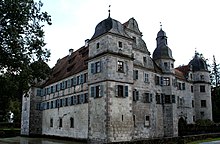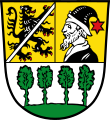Würtzburg



Würtzburg is the name of a Franconian noble family that died out in 1922 .
history
Origin and possessions
The family had a documented line of tribe since the 12th century . Herold appeared as the first representative in 1140, who was appointed Vitzdom in the Diocese of Würzburg in 1153 . His son Boto married a daughter of the von Pappenheim family in 1156. Her father was Marshal Heinrich von Pappenheim. The couple fathered two sons, Herold and Boto [the younger], the latter being mentioned in a document in 1220.
In 1359 Konrad von Würtzburg acquired the village of Rothenkirchen (today a district of the Markt Pressig ) in the diocese of Bamberg , for which Emperor Charles IV granted him the stick and gallows (the high jurisdiction ) and market rights in 1377 .
In 1575 Hieronymus von Würtzburg acquired the moated castle Mitwitz, which had only been poorly repaired since a fire in 1525 . Under Hans Veit I von Würtzburg, the castle was given its present form at the end of the 16th century. In 1594, the Upper Mitwitz Castle also came into the family's possession . Both castles remained in the possession of the von Würtzburg family until 1922.
From the 16th to the beginning of the 19th century, the Lords of Würtzburg belonged to the imperial knighthood in the knightly canton of the Franconian knightly circle and at the end of the 18th century also to the knightly canton of Rhön-Werra because of the ownership or partial ownership of Röttingen and Tauberrettersheim .
The family has produced important loved ones. Numerous members were canons of Würzburg and Bamberg . Veit II von Würtzburg (* 1536; † 1577) was Prince-Bishop of Bamberg from 1562 to 1577 and builder of the Renaissance wing of the old court . Johann Karl von Würtzburg, imperial secret councilor , received the status of hereditary - Austrian baron from Emperor Leopold I in 1672 . The family died out in 1922 with the death of Ludwig Freiherr von Würtzburg.
Possessions
Name bearer of the lineage
- Herold [I.] von Würtzburg (lived around 1140 to 1153): from 1153 Vicedominus in the diocese of Würzburg ; fathered son Boto
- Boto [I.] von Würtzburg (* before 1156): ⚭ 1156 NN von Pappenheim (noble family) , daughter of Marshal Heinrich von Pappenheim; begat two sons, Herold [the younger] and Boto [the younger]
- Herold [the younger] von Würtzburg, (* around 1156): still mentioned in a document in 1220
- Boto [the younger] von Würtzburg (* around 1156)
- Boto [I.] von Würtzburg (* before 1156): ⚭ 1156 NN von Pappenheim (noble family) , daughter of Marshal Heinrich von Pappenheim; begat two sons, Herold [the younger] and Boto [the younger]
- Heinrich von Würtzburg (Canon in Würzburg around 1521)
- Konrad von Würtzburg (lived around 1359)
- Hieronymus von Würtzburg (lived around 1575)
- Hans [Johann] Veit I. von Würtzburg (lived at the end of the 16th century): Bamberg canon
- Veit II. Von Würtzburg († 1577): Prince-Bishop of Bamberg (1561–1577)
- Johann Veit Freiherr von Würtzburg: Würzburg canon
- Ludwig Freiherr von Würtzburg († 1922): honorary citizen of the city of Bad Kissingen , awarded in 1881
coat of arms
Blazon : The coat of arms shows in gold the torso of a bearded man in a black dress with a silver collar and a black pointed hat on top of a silver, the drooping tip of which is decorated with a gold star; On the helmet is a peacock feather bush between two gold-black and black-gold peacock feathers; the helmet covers are black and gold.
In Siebmacher in blazon is the length portrait of a white-bearded man on a golden background shown. He wears a sloping, pointed hat with a red star on the end; the clothing, which is also black, is characterized by a white (silver) collar.
The bearded man is a heather head and still appears today in some Upper Franconian coats of arms.
Coat of arms of the Stockheim community
Coat of arms of the Mitwitz market
Coat of arms of the market in Nordhalben
See also
literature
- Otto Hupp : Munich calendar 1912. Munich / Regensburg publishing house 1912.
- Gerhard Köbler : Historical lexicon of the German countries. The German territories from the Middle Ages to the present. 7th, completely revised edition. CH Beck, Munich 2007, ISBN 978-3-406-54986-1 .
- Wilhelm Hotzelt: Family History of the Barons von Würtzburg Verlagbuchhandlung Herder & Co. GmbH, Freiburg im Breisgau, 1931
Individual evidence
- ^ Wolfgang Schneider: Folk culture and everyday life. In: Ulrich Wagner (Hrsg.): History of the city of Würzburg. 4 volumes, Volume I-III / 2, Theiss, Stuttgart 2001–2007, Volume 1 (2001): From the beginnings to the outbreak of the Peasants' War. ISBN 3-8062-1465-4 , pp. 491–514 and 661–665, here: p. 506.


